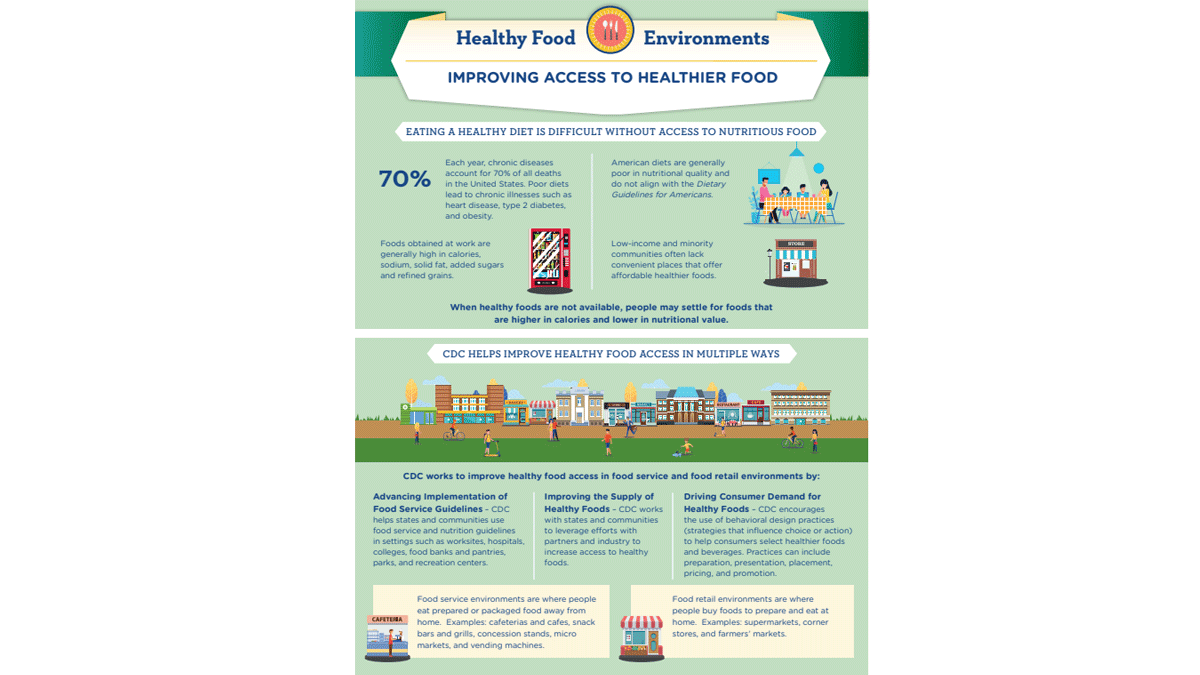At a glance
Poor diets lead to chronic diseases. Making healthy food available and affordable in key settings allows people to make healthier food choices. States, communities, early care and education programs, and schools can each create healthy food environments.

Introduction
Chronic diseases account for 70% of all U.S. deaths every year. Poor diets contribute to chronic diseases such as heart disease, type 2 diabetes, and obesity. Some communities and people with lower incomes are more likely to lack convenient places that offer affordable, healthier foods.
Providing healthy and affordable food in key settings allows people to make healthier choices. When healthy foods are unavailable, people may settle for foods that are higher in calories and lower in nutritional value.
Strategies
Many strategies can help create and support healthy food environments. Examples include:
- Applying food service or nutrition standards in multiple settings, including hospitals, worksites, food banks, and food pantries.
- Providing incentives for food retailers, including farmers' markets, to establish businesses in underserved areas.
- Working with partners or industry to improve the supply of healthy foods.
- Using behavioral design practices—such as pricing and placement—to influence people's food and beverage choices or actions.
- Linking local food hubs to small businesses that sell or serve food.
- Supporting farm-to-institution programs.

What states and communities can do
State and local health department staff and community organizations can support healthier food and beverage access in several ways. Two strategies are highlighted here:
- Implement food service and nutritional guidelines.
- Establish fruit and vegetable voucher incentive and produce prescription programs.
Public health practitioners can work with partners to implement food service and nutrition guidelines and fruit and vegetable programs. Common topics of interest include health access, environmental sustainability, waste reduction, economic development, and cultural food preferences.
Food service and nutritional guidelines
State and local health departments can promote healthier foods and beverages using the Food Service Guidelines for Federal Facilities in facilities that are state or locally owned or operated. They can also:
- Encourage other institutions—such as recreational centers, colleges and universities, hospitals, and other worksites—to implement food service guidelines.
- Bring together partners, such as leadership or wellness staff, at these institutions.
- Reach out to professional organizations, such as hospital associations, and offer technical assistance and training as needed.
For organizations that distribute food, such as food banks or pantries, the Healthy Eating Research Nutrition Guidelines for the Charitable Food System is recommended for use.
Resources
Strategies for Food Service and Nutrition Guidelines
Includes background, potential state and local activities, examples of what others are doing, and resources.
Food Service Guidelines for Federal Facilities
Helps increase healthy food and beverage choices and sustainable practices in federal worksites. Can be used for cafeterias, concession stands, snack bars, and vending machines.
Food Service Guidelines Implementation Toolkit
Describes how to build a foundation, strategize and act, monitor and evaluate, and expand food service guidelines initiatives.
Tips for Offering Healthier Options and Physical Activity at Workplace Meetings and Events
Provides suggestions and resources for increasing healthier foods and beverages at worksite meetings, conferences, and events. Also includes physical activity opportunities for employees throughout the workday.
Fruit and vegetable voucher incentive and produce prescription programs
State and local health department staff can support this strategy in many ways, such as:
- Providing state benefit coverage for patients enrolled in these programs.
- Supporting local policies that make it easier for food retailers that accept incentives or prescriptions.
- Working with representatives from Medicaid programs, including state agencies, payers, and health systems, to implement, expand, and evaluate fruit and vegetable programs.
Health department staff and local organizations can help local programs identify funding sources for:
- Developing and implementing pilot programs.
- Buying produce.
- Supporting nutrition education.
Resources
Voucher Incentives and Produce Prescriptions
Provides background of fruit and vegetable programs and is a landing page to more detailed information on these programs.
Nutrition Incentive Hub
Resources to support nutrition incentive and produce prescription projects. Provides information about training, technical assistance, reporting, evaluation, and marketing and communications.
Supporting Food and Nutrition Security Through Healthcare
Information to help health care systems and their public health partners increase access to nutritious food for patients at high risk of food insecurity.

What early care and education programs can do
Early care and education (ECE) programs can use science-based best practices to increase consumption of healthy food and beverages and support breastfeeding families. The federal Child and Adult Care Food Program reimburses ECE programs for supporting breastfeeding parents and serving healthy meals and snacks. This program also offers free resources and training to help meet program requirements.
Resources
Strategies for Early Care and Education
Background, potential state and local activities, examples of what others are doing, and resources.
Early Care and Education Resources
Resources that states, communities, or ECE providers can use to create healthy eating environments in ECE settings.
What schools can do
School leadership and staff can follow the nutrition standards for school meals, including the National School Lunch Program and the School Breakfast Program. Smart Snacks in School standards also provide nutritional guidance for foods sold in vending machines, school stores, or other a la carte venues outside of federal meal programs.
School leadership and parent-teacher organizations can work together to buy salad bars to increase access to fruits and vegetables. Teachers and other staff can also encourage their students to drink water instead of sugary drinks. Schools can ensure access to free drinking water before, during, and after school as an alternative to drinking sugary beverages.
Resources
School Nutrition
Covers the components of the school nutrition environment and services.
Water Access in Schools
Describes the requirements for having access to drinking water, provides short video training modules, and includes a toolkit for increasing access to drinking water in schools.
Collection of Evidence-Based Strategies for School Nutrition and Physical Activity
Includes peer-reviewed articles.
What CDC is doing
CDC works to improve healthy food access in food service, food distribution centers, and food retail environments by:
Advancing implementation of food service guidelines. CDC helps states and communities use food service and nutrition guidelines by providing funding and technical assistance.
Coordinating programs for fruit and vegetable voucher incentives and produce prescriptions. CDC helps states and communities implement and expand these programs by providing funding and technical assistance.
Improving the supply of healthy foods. CDC works with states and communities to leverage efforts with partners and industry to increase access to healthy foods.
Driving consumer demand for healthy foods. CDC encourages using behavioral design practices, which can include preparation, presentation, placement, pricing, and promotion.
Providing funding and technical assistance to support early child nutrition. CDC works with states and communities to apply nutrition policies and activities in ECE settings.
